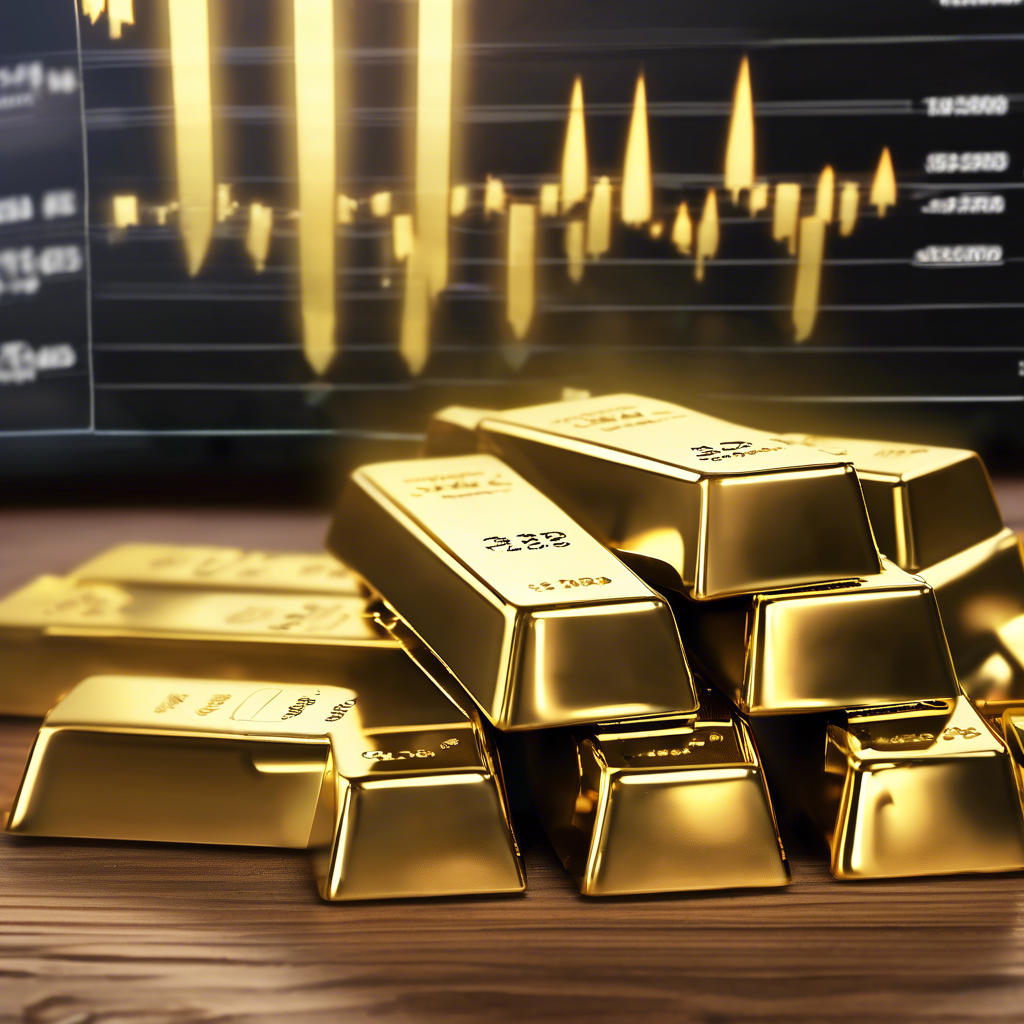Introduction to Gold Market Analysis and Price Movements
The gold market has always been a focal point for investors seeking stability and value preservation. Understanding the current price movements is crucial for making informed investment decisions. This article delves into the dynamics of the gold market, examining the factors influencing prices and offering insights for potential investors.
Key Factors Influencing Gold Prices
Several factors contribute to the fluctuations in gold prices, making it essential for investors to stay informed. One primary influence is the global economic environment. Economic instability often drives investors toward gold as a safe-haven asset, increasing demand and subsequently raising prices.
Additionally, inflation rates play a significant role in shaping investor sentiment. When inflation rises, the purchasing power of currency declines, leading to a surge in gold investments. This relationship between gold and inflation highlights the importance of monitoring economic indicators.
Interest Rates and Their Impact
Interest rates are another pivotal factor affecting gold prices. Typically, when interest rates decrease, gold prices tend to rise. Lower rates reduce the opportunity cost of holding gold, making it a more attractive investment. Conversely, rising rates can lead to a decline in gold prices as investors seek higher returns in interest-bearing assets.
Supply and Demand Dynamics
The fundamental principle of supply and demand also significantly impacts gold prices. Global gold production, mining outputs, and demand from various sectors, including jewelry and technology, are critical elements to consider. For example, a surge in demand for gold jewelry during festive seasons can temporarily boost prices.
Analyzing Current Trends in Gold Prices
To effectively navigate the gold market, investors must analyze current trends and historical data. Understanding gold price forecasts can provide valuable insights into potential future movements. Historical analysis reveals patterns that can guide investment strategies and help mitigate risks.
Moreover, geopolitical factors and market speculation often contribute to short-term price volatility. Staying updated on news related to international relations, trade agreements, and economic policies can enhance an investor’s ability to predict price movements effectively.
Conclusion: Making Informed Decisions in the Gold Market
In conclusion, a thorough understanding of the gold market, including the key factors affecting prices and current trends, is vital for any investor. Whether you are a seasoned investor or a newcomer to the gold market, leveraging insights from past trends and future insights can empower you to make informed decisions that align with your investment goals.
Understanding Gold Demand Trends for 2025
As we look ahead to 2025, comprehending gold demand trends becomes indispensable for investors aiming to capitalize on market movements. Factors such as geopolitical tensions and shifts in economic policies can drive demand, making it critical to stay informed. Analyzing key indicators will enable you to forecast demand accurately and position your investment strategy accordingly.
The Role of Central Banks
Central banks across the globe are significant players in the gold market, often acquiring large quantities of gold to diversify their reserves. Understanding the implications of central bank purchases can help investors gauge market sentiment and future price movements. For example, if central bank purchases increase, it typically signals confidence in gold as a long-term investment, which can lead to price appreciation.
Technological Advancements and Gold Demand
In recent years, the demand for gold in technology has surged, with applications in electronics and renewable energy. Technological advancements drive an increase in gold utilization, which can affect market dynamics significantly. Investors should monitor trends in technology to identify potential growth areas for gold.
Investment Strategies for Gold: Maximizing Returns
Adopting effective investment strategies is crucial for maximizing returns in the gold market. Whether you are considering physical gold investments, gold ETFs, or mining stocks, understanding the pros and cons of each option is vital. For detailed insights, refer to this comprehensive comparison of different gold investment types.
Short-Term vs. Long-Term Investments
Investors must decide between short-term and long-term strategies. Short-term trading can capitalize on price fluctuations, while long-term investments typically benefit from the overall appreciation of gold over time. Assessing your risk tolerance and investment goals is essential in making this decision.
Using Gold ETFs for Diversification
Gold ETFs (Exchange-Traded Funds) provide an excellent opportunity for diversification within your investment portfolio. These funds allow investors to gain exposure to gold without the need for physical storage. They can also be a cost-effective option for new investors looking to enter the gold market. To explore more about gold ETFs, check out this insightful post on the advantages of gold ETFs.
Risk Management in Gold Investments
Like any investment, gold comes with its own set of risks. Understanding these risks is crucial for successful portfolio management. Factors such as market volatility, changes in interest rates, and global economic conditions can impact gold prices. To mitigate risks, consider diversifying your portfolio and utilizing risk management techniques. For more strategies, review this guide on effective gold investment strategies.
Monitoring Market Trends
Keeping an eye on market trends and forecasts can help investors make informed decisions. Regularly reviewing gold price predictions and market analyses will enable you to adjust your strategy as needed. For current insights, visit this resource on gold price trends.
Understanding Gold Investment Opportunities in 2025
As we advance into 2025, the landscape of gold investments continues to evolve, presenting unique opportunities for savvy investors. Grasping the intricacies of gold market dynamics is essential for making informed decisions. Investors should explore not only traditional gold assets but also emerging avenues such as gold-backed cryptocurrencies and digital gold platforms. These innovations are reshaping how individuals interact with the gold market and can enhance portfolio diversification.
Exploring Gold Stocks and Mining Investments
Investing in gold mining stocks can be a lucrative strategy, particularly when gold prices are on the rise. Major mining companies often benefit from increased demand, which translates to higher stock values. However, it’s crucial to evaluate individual mining operations and their production costs. For instance, factors such as geopolitical risks and environmental regulations can impact profitability. Conducting thorough research on companies can help investors identify promising mining stocks that align with their investment goals.
Gold Mutual Funds: A Convenient Investment Option
Gold mutual funds offer a practical way to invest in gold without directly purchasing physical assets. These funds pool money from multiple investors to acquire shares in gold-related assets, including mining companies and gold ETFs. This investment option provides diversification and professional management. For those new to gold investments, gold mutual funds can be a less risky entry point. To learn more about this investment type, check out this insightful article.
The Impact of Economic Factors on Gold Investments
Economic conditions play a pivotal role in shaping gold demand and prices. Interest rates, inflation, and currency fluctuations can significantly influence investor sentiment. For example, when inflation rises, gold often serves as a hedge against eroding purchasing power. Consequently, understanding these economic indicators is vital for predicting market movements. Regularly monitoring economic forecasts can help investors time their entry or exit in the gold market effectively.
Global Events and Their Significance
Geopolitical events, such as trade wars or conflicts, can lead to increased gold demand as investors seek safe-haven assets. Historical trends indicate that during times of uncertainty, gold prices tend to rise as investors flock to this stable asset. Staying informed about global developments can empower investors to anticipate shifts in gold demand. For insights into how global factors influence gold prices, refer to this detailed post.
Utilizing Risk Management Techniques
Effective risk management is crucial for navigating the gold investment landscape. Investors should consider strategies such as setting stop-loss orders and diversifying their portfolios with other asset classes. For instance, combining gold with stocks and bonds can create a balanced investment approach that mitigates potential losses during market volatility. To explore more about risk management strategies, visit this comprehensive guide.
Identifying Future Gold Investment Trends
As we approach 2025, several trends are emerging that could shape gold investment strategies. Understanding these trends is essential for investors looking to leverage potential opportunities in the gold market. One significant trend is the rise of sustainable and ethical gold investments. With increasing awareness of environmental and social issues, investors are seeking gold sources that adhere to ethical mining practices. This shift can influence demand and pricing dynamics in the gold market, making it crucial for investors to consider the ethical implications of their investments.
The Role of Technology in Gold Investments
Technological advancements are also playing a vital role in transforming the gold investment landscape. Innovations such as blockchain technology are enhancing transparency in gold transactions, making it easier for investors to track the provenance of their gold. This can bolster confidence among investors, particularly in the context of gold-backed cryptocurrencies. Furthermore, the development of digital gold platforms is streamlining the buying and selling process, allowing investors to engage with the market more efficiently. For insights into these technological shifts, check out this comprehensive overview.
Maximizing Your Gold Investment Portfolio
To maximize returns from gold investments, diversification is key. Investors should explore a mix of asset types, including physical gold, gold ETFs, and gold mining stocks. Each asset class offers unique advantages and risks. For instance, while physical gold provides tangible security, gold ETFs offer liquidity and ease of trading. Understanding the interplay between these different types of investments can help investors create a robust gold investment portfolio. To learn more about effective investment strategies, visit this informative guide.
Assessing Gold Market Indicators
Investors should also focus on key market indicators when assessing gold investment opportunities. Monitoring gold price trends, interest rates, and geopolitical developments can provide valuable insights into market directions. For example, rising interest rates may negatively impact gold prices, while economic instability could boost demand for gold as a safe-haven asset. Regularly reviewing market analyses and forecasts can equip investors with the knowledge needed to navigate the complexities of the gold market. A detailed examination of these indicators can be found in this article.
Preparing for Volatility in Gold Investments
Market volatility is an inherent aspect of gold investments, and being prepared for fluctuations is vital. Implementing risk management strategies, such as setting stop-loss orders and maintaining a diversified portfolio, can help mitigate potential losses. Additionally, staying informed about global economic conditions can assist investors in anticipating market shifts. For those looking to deepen their understanding of risk management in gold investments, this guide offers essential insights and techniques to ensure a balanced approach to investment.
Comprehensive FAQ Section on Gold Investments
1. What are the primary factors influencing gold prices?
The primary factors influencing gold prices include inflation rates, interest rates, currency strength, geopolitical stability, and demand from sectors such as jewelry and technology. Understanding these factors can help investors make informed decisions regarding their gold investments.
2. How can I start investing in gold?
To start investing in gold, you can choose from various methods, including purchasing physical gold (like coins or bars), investing in gold ETFs, or buying shares in gold mining companies. Each method has its benefits and risks, so it’s essential to research and choose the one that aligns with your investment goals.
3. Is investing in gold a safe option during economic downturns?
Gold is often considered a safe-haven asset during economic downturns due to its historical performance as a store of value. Investors tend to flock to gold in times of uncertainty, which can drive up its price. However, it’s crucial to maintain a diversified portfolio to mitigate risks.
4. What are gold-backed cryptocurrencies?
Gold-backed cryptocurrencies are digital currencies that are pegged to the value of physical gold. Each token typically represents a specific amount of gold, providing investors with a way to invest in gold through blockchain technology. This innovation combines the security of gold with the convenience of digital assets.
5. How does inflation impact gold investment?
Inflation can lead to an increase in gold prices as investors seek to hedge against the decreasing purchasing power of currency. Historically, gold has been viewed as a reliable store of value during inflationary periods, making it an attractive investment for many.
6. What are the risks associated with gold investments?
While gold is often seen as a stable investment, it does carry risks, including price volatility, storage costs for physical gold, and liquidity issues with certain gold investment vehicles. Understanding these risks is essential for developing a comprehensive investment strategy.
7. Can I invest in gold through my retirement account?
Yes, many retirement accounts, such as IRAs, allow investments in gold through specific gold-backed ETFs or by holding physical gold within a self-directed IRA. However, it is important to follow IRS regulations regarding the types and amounts of gold you can hold.
8. How often should I review my gold investment portfolio?
It’s advisable to review your gold investment portfolio at least annually, or whenever there are significant market changes or shifts in your financial goals. Regular reviews can help you adjust your strategy and maintain alignment with your overall investment objectives.
9. What is the best time to invest in gold?
The best time to invest in gold depends on market conditions, economic indicators, and personal financial situations. Monitoring trends and indicators such as inflation rates and geopolitical developments can help you determine the right time for investment.
10. Are there any taxes associated with gold investments?
Yes, gold investments can be subject to capital gains tax, especially when sold for a profit. The tax rate may vary based on how long the gold was held and the investor’s tax bracket. Consulting a tax professional can provide clarity on tax implications.
Authority Resources for Gold Investment Insights
Investing wisely in gold requires access to reliable information and expert insights. Here are some trusted resources that can enhance your understanding of gold investments:
- Investopedia – Gold Investment Overview
- Kitco – Precious Metals Market News
- World Gold Council – Research and Insights
- BullionVault – Gold Pricing and Investment
- ABC News – Business and Economic News
Conclusion
As we look towards the future of gold investments, it is clear that understanding market trends, leveraging technology, and implementing effective strategies are paramount for success. By diversifying your portfolio and staying informed about key market indicators, you can navigate the complexities of the gold market with confidence. With the right knowledge and resources at your disposal, gold investments can serve as a robust component of your financial strategy, helping you secure your wealth in an ever-changing economic landscape.











What caught my attention in this analysis is the nuanced role of interest rates in shaping gold prices. The inverse relationship where lower interest rates make gold more appealing due to reduced opportunity costs is well explained, but I think it’s important to highlight how quickly this factor can shift investor behavior. In my experience following market cycles, sudden adjustments in central bank policies can lead to sharp gold price volatility. This makes timing crucial for both short-term traders and long-term holders. Additionally, the surge in gold demand driven by technological advancements, especially in sectors like electronics and renewable energy, introduces a fascinating angle that isn’t often front and center. It shows that gold is not just a traditional safe-haven but also a vital industrial element. Has anyone else noticed how green tech initiatives might further influence gold demand over the next few years? I’m curious about what strategies others might be using to balance the inflation hedge aspect with these emerging demand factors when planning their gold investments.
This article provides a comprehensive overview of the current factors influencing the gold market, which I find particularly useful for long-term planning. From what I’ve observed, the interest rates’ impact on gold prices can be quite volatile, especially when central banks unexpectedly change monetary policies. It raises an interesting question about the timing of investments—what signals are most reliable for predicting these swift shifts? Also, the mention of technological growth augmenting gold demand resonates with my experience; I’ve seen rising interest in gold for electronics, especially in renewable energy components, which could sustain the industrial demand for years. I wonder, with the shift toward sustainability, how will this influence gold mining practices and supply in the future? Has anyone here explored investments specifically in ethically sourced or eco-friendly gold? It seems like a promising area, given the increasing consumer and regulatory focus on social responsibility. Would love to hear others’ insights on how these trends might shape the gold investment landscape, especially in regard to balancing industrial demand with long-term investment stability.